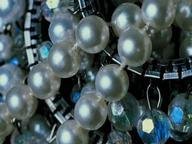Quiz Answer Key and Fun Facts
1. The Snettisham Hoard was a collection of Iron Age treasures, which included several torcs (or torques). On which part of the body would a torc be worn?
2. Spain has been making man made pearls with authentic components since the 1890s. They are named after the island they are produced on, can you name this island?
3. In many cultures, jewelry is worn not only for adornment, but body modification. Which of these types of jewelry are NOT used for body modification?
4. Turquoise is a gem that has been mined for thousands of years. Which of these is NOT a place where turquoise can be found naturally?
5. Since 1923, brides of the British Royal Family have worn wedding rings made from gold mined in which part of the United Kingdom?
6. Perhaps the ultimate in body adornment might be considered a burial suit, such as those archeologists have found in China. Sewn together with thread of gold, silver or silk, what ornamental stone was used to create these suits?
7. Which of these prized stones, often hung from a necklace as a pendant, originated from tree resin?
8. What are Japanese hair ornaments called?
9. The town of Whitby in North Yorkshire is known for which semi-precious stone which was popularized by Queen Victoria who wore it when in mourning?
10. One of the oldest stones used for jewellery is lapis lazuli. Which vivid colour is it?
Source: Author
mlcmlc
This quiz was reviewed by FunTrivia editor
kyleisalive before going online.
Any errors found in FunTrivia content are routinely corrected through our feedback system.


